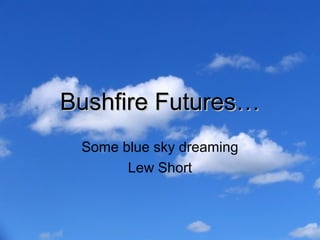
Futures - blue sky dreaming 2010
- 1. Bushfire Futures… Some blue sky dreaming Lew Short
- 2. Adaptive management • Adaptive management is a structured, iterative process of optimal decision making in the face of uncertainty, with an aim to reducing uncertainty over time via system monitoring. In this way, decision making simultaneously maximizes one or more resource objectives and, either passively or actively, accrues information needed to improve future management. • AM is often characterized as "learning by doing."
- 3. Key Challenges • Catastrophic fires • New type of fire fighting? – beyond defensive – life • Warnings protection • Keeping abreast of • Ability to manage Royal Commission large events findings & responding • Situational awareness to them in a coordinated and • Fire modelling strategic manner that • Coordinated fire support how we do fighting business and add • Communications value • Doctrine • Climate change
- 4. Wicked Problems • "Wicked problem" is a phrase used in social planning to describe a problem that is difficult or impossible to solve because of incomplete, contradictory, and changing requirements that are often difficult to recognize. • Moreover, because of complex interdependencies, the effort to solve one aspect of a wicked problem may reveal or create other problems.
- 5. Wicked Problems Conklin identifies the following as defining characteristics of wicked problems: • The problem is not understood until after the formulation of a solution. • Wicked problems have no stopping rule. • Solutions to wicked problems are not right or wrong. • Every wicked problem is essentially novel and unique. • Every solution to a wicked problem is a 'one shot operation' • Wicked problems have no given alternative solutions.
- 6. Climate Change • over the next 100 years projected temperature rise is likely to be greater than any seen over the last 1000 years (BOM). • Australia has experienced a warming trend in maximum temperature during recent decades.
- 7. • There will be less water in South Eastern Australia and temperatures will rise by 1.4 – 5.8 decrees Celsius (BOM).
- 8. Future Under Climate Change • Worsening fire behaviour – Increase in fire intensity – Increase in number of fires – Increase in very high and extreme fire danger days • Limits to fire suppression and attack • Reduced window of opportunity for prescribed burning • Need for increased reliance on fire mitigation and personal preparedness • Change to current practices… innovation & change
- 9. The Future… • Emergency leaders of the future will have to contend with changes in demographics, water and fuel availability, technological change as well as enhanced natural phenomenon of cyclones, drought, tsunami, severe storms and increased frequency and intensity of bushfires as a result of climate change. • Fire and emergency leaders will need to adapt to these changes which will confront their traditional operational focus and challenge them to look at other mechanisms.
- 11. Models • Phoenix enabled fire authorities to determine where a fire was likely to be so they could send resources there ahead of time. • Phoenix uses a single stream of weather conditions for wind speed and direction, but will add a model from the US (called Wind Ninja) that uses topography to determine local wind speed and directions so wind movement over hilly terrain can be extrapolated. For example, fire moves faster up a hill as there is a smaller area the higher up it advances http://www.smh.com.au/news/technology/biztech/a-new-front-in- fighting-fires/2009/02/23/1235237560187.html
- 15. • http://www.aph.gov.au/hous e/committee/bushfires/inqui ry/subs/sub492.pdf
- 17. Amatoya Suppression Vehicle • Designer Liam Ferguson's vision of how to fight fires - concept • The Amatoya is a site recon and light tanker vehicle designed with a philosophy much more military than civilian. • The seating position is like that of a AH-1 Cobra gunship, with the co-pilot up and behind the driver. • The Amatoya is built on a monococque steel body, like armed forces MRAPs, insulated with NASA's aerogel, and painted with "military grade sacrificial thermo ceramic intumescent paints.“ • The Remotely Operated Suppression Cannon Outfit (ROSCO) has a 2,200-liter total water capacity, all the better for the fact that the crew members don't need to leave the vehicle to employ it. • Nor should they have much problem getting to the fire, with absurd clearances all around, directional spotlights, and a thermal imaging camera.
